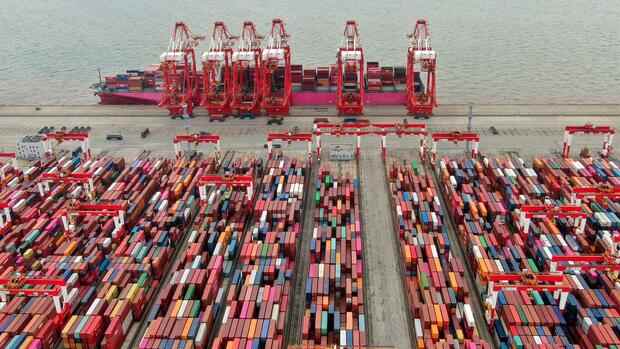In terms of trade in goods, the omicron wave has so far primarily posed a threat to China.
(Photo: dpa)
Berlin Traffic jams on international container shipping routes continue to impede the supply of goods and raw materials worldwide. “Around 11 percent of all goods shipped worldwide are currently stuck in traffic jams,” reported the Kiel Institute for the World Economy (IfW) on Monday. “In the Red Sea, the most important trade route between Europe and Asia, there are currently around 11 percent fewer goods than usual.”
At the same time, world trade is growing strongly and, according to the IfW economists, is now even above the level before the Corona crisis. Against this background, IfW economist Vincent Stamer interprets the ongoing supply bottlenecks as “an expression of an extremely rapid increase in demand that supply cannot keep up with”.
Consumers and businesses have been suffering from persistent disruptions in global supply chains for many months. The corona pandemic has messed up the schedules of the liner shipping companies, partly because ports have repeatedly been closed after corona outbreaks. In addition, the economy picked up earlier and more vigorously than in Germany, especially in America, the world’s largest economy. This ensures that global transport capacities are stretched beyond measure.
The IfW sees the pandemic, which is escalating more than ever with the current omicron wave, primarily as a threat to China, the world’s second largest economy after the USA. But that could change: “It is to be feared that delays in China’s container handling would also affect Europe’s trade,” says Stamer. “The Chinese New Year and the hosting of the Olympic Games are a test for China to ensure that the pandemic situation and thus the economic outlook do not deteriorate.”
Top jobs of the day
Find the best jobs now and
be notified by email.
The Chinese authorities are already fighting smaller strands of infection with tough measures. In the past few weeks, they have imposed lockdowns in several cities across the country. Among other things, this led to production stops in factories, logistical delays and a slump in domestic consumption.
For Germany, the prospects for both exports (+1.2 percent) and imports (+0.8 percent) are positive. “Despite the omicron wave, world trade is booming like never before,” emphasized Stamer. “The ongoing supply bottlenecks are therefore an expression of an extremely rapid increase in demand that supply cannot keep up with.”
More: Is globalization over? Five facts prove the opposite
